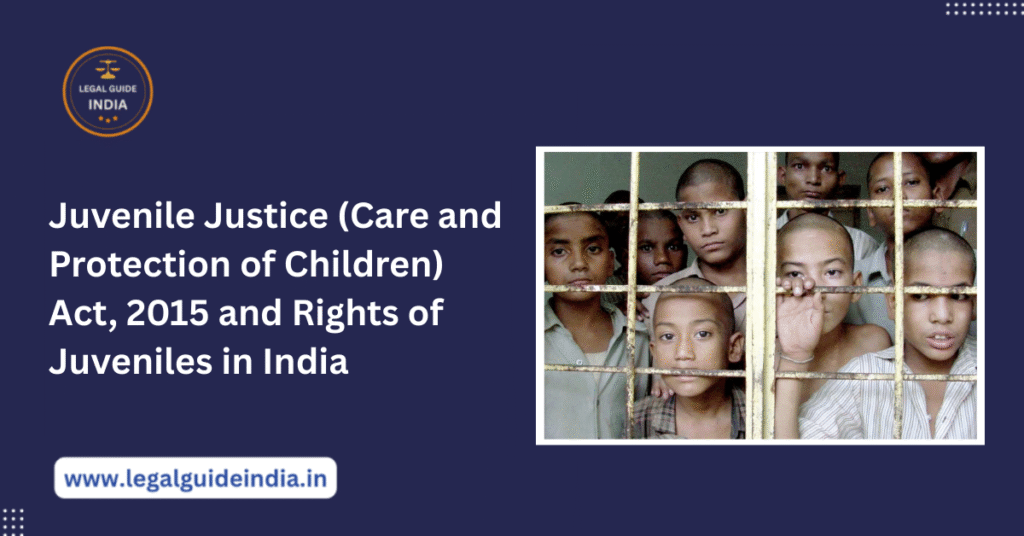The Juvenile Justice (Care and Protection of Children) Act, 2015 is one of the most significant legislations in India dealing with the rights, care, and protection of children. Juvenile Justice Act provides a legal framework to address two broad categories of children:
- Juveniles in conflict with the law, meaning those below the age of 18 who are accused of committing an offence.
- Children in need of care and protection, including abandoned, orphaned, and neglected children who require state support.
The JJ Act is designed to ensure child-friendly procedures, rehabilitation, and reintegration into society while also holding juveniles accountable for their actions. The law emerged after widespread debates following the 2012 Nirbhaya case, where the involvement of a juvenile in a heinous crime sparked nationwide demand for stricter measures.
Historical Background of Juvenile Justice in India
The evolution of juvenile laws in India reflects the changing perception of society towards young offenders:
- Juvenile Justice Act, 1986 – First consolidated law on juvenile justice, focusing primarily on care and protection.
- Juvenile Justice Act, 2000 – Introduced reforms to align India’s laws with the UN Convention on the Rights of the Child (UNCRC).
- Juvenile Justice Act, 2015 – A major overhaul, allowing children aged 16–18 to be tried as adults in heinous crimes such as murder and rape, while strengthening provisions for adoption and child welfare.
This legal journey highlights India’s attempt to balance child rights protection with public safety and justice delivery.
Key Features of the Juvenile Justice Act, 2015
- Juveniles in Conflict with Law
- Children between 16–18 years accused of heinous crimes can be tried as adults after an assessment by the Juvenile Justice Board (JJB).
- The assessment considers the child’s mental capacity, maturity, and understanding of the consequences.
- Children in Need of Care and Protection
- Includes abandoned, orphaned, and street children.
- Such children are produced before the Child Welfare Committee (CWC), which ensures their safety, rehabilitation, and access to essential services.
- Juvenile Justice Board (JJB)
- Composed of a magistrate and two social workers.
- Handles cases involving children in conflict with law and ensures a child-friendly process.
- Child Welfare Committee (CWC)
- Deals with the care, protection, and rehabilitation of children in distress.
- Has powers to send children to foster care, children’s homes, or fit facilities.
- Adoption Provisions
- The JJ Act 2015 introduced streamlined adoption procedures through the Central Adoption Resource Authority (CARA).
- Both Indian and foreign nationals can adopt under uniform guidelines.
- Rehabilitation and Social Integration
- Focus on counseling, foster care, sponsorship, and after-care programs.
- Emphasis is placed on helping children rebuild their lives rather than leaving them stigmatized.
Rights of Juveniles under the Act
The Juvenile Justice Act guarantees several rights to juveniles, ensuring dignity and protection. These include:
- Right to Legal Aid – Every child has the right to free legal services.
- Right to Privacy – Juvenile identities cannot be disclosed in the media.
- Right to Education and Health – Ensuring continued schooling, healthcare, and nutrition.
- Right to Protection from Exploitation – Safeguards against child labour, trafficking, and abuse.
- Right to Rehabilitation – Juveniles are given opportunities to reform instead of being condemned by a purely punitive system.
Juveniles Tried as Adults: The Controversial Provision
One of the most debated aspects of the 2015 Juvenile Justice Act is the provision that allows 16–18-year-olds to be tried as adults for heinous offences.
- Supporters’ View: This creates a sense of deterrence, especially in cases of grave crimes such as rape and murder. It responds to public concerns that older juveniles are capable of understanding the nature of their acts.
- Critics’ View: Child rights activists argue that this contradicts the principle of juvenile reformation. Many believe children in this age group are vulnerable and influenced by poverty, peer pressure, or abuse, and thus deserve rehabilitation rather than harsh punishment.
This debate continues to shape the discourse on how society perceives justice for minors.
Amendments and Reforms in Juvenile Justice
Since its enactment, the Juvenile Justice Act has been amended and updated to improve efficiency. For example:
- 2021 Amendment gave district magistrates greater responsibility in adoption cases, aiming to reduce delays.
- Stronger provisions have been added to ensure accountability of child care institutions.
- Regular monitoring by state and national commissions helps track the implementation of child protection laws.
Why the Juvenile Justice Act 2015 is Important
- Protects Vulnerable Children – Ensures a legal safety net for children without family support.
- Balances Justice and Reform – Holds juveniles accountable while still prioritizing rehabilitation.
- Complies with International Standards – Aligns India’s legal framework with UNCRC and Hague Convention on adoption.
- Strengthens Institutional Framework – Establishes JJBs, CWCs, and monitoring bodies to create a holistic child welfare system.
Case Studies and Practical Application
- Nirbhaya Case (2012): Highlighted the gap in existing laws, leading to stricter measures in the 2015 Act.
- Juvenile Rehabilitation Programs: Many states have successfully implemented after-care programs, helping children reintegrate into mainstream society with education and vocational training.
These examples underline the importance of viewing children not just as offenders but as individuals capable of change.
Useful Links for Readers
- Juvenile Justice Act 2015 PDF
- JJ Amendment Act 2021 PDF
- National Commission for Protection of Child Rights (NCPCR)
- Ministry of Women & Child Development
- Central Adoption Resource Authority (CARA)
Conclusion
The Juvenile Justice Act, 2015 represents a landmark step in protecting children’s rights in India. While it has drawn criticism for its adult-trial provision, it continues to serve as a vital framework balancing justice, welfare, and rehabilitation. Ensuring proper implementation, increased awareness, and continued reforms will make this law more effective in addressing the complex issues of juvenile justice.
By safeguarding the rights of juveniles and providing them with opportunities for reformation, the JJ Act not only serves justice but also invests in a more responsible and compassionate future generation.
To read more Indian Laws and news, visit Legal Guide India



